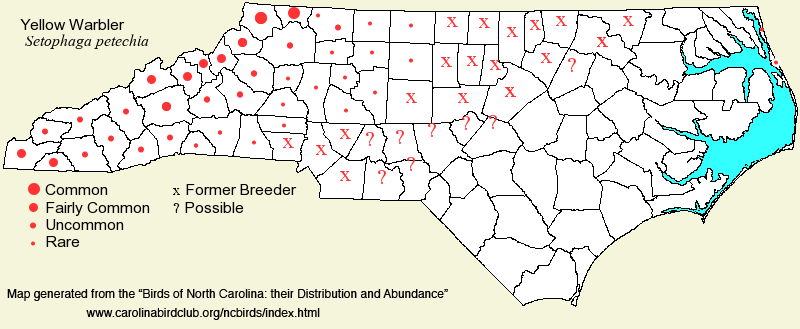 |  |
|
Yellow Warbler - Setophaga petechia PARULIDAE Members: | Search Common: Search Scientific: |
|
|
|||||||
| General Comments | The Yellow Warbler has one of the most extensive breeding ranges of any warbler -- across nearly all of the boreal forest region south to the northern two-thirds of the United States. Despite the fact that it nests in shrubby areas and willow thickets across its range, and such habitats are not in obvious decline, the species has greatly withdrawn from much of the southern portion of its breeding range, especially in North Carolina. Many decades ago, the species nested over most of the state's Piedmont, east to the Raleigh area, and along the northern coastal areas. By 1980, it became rare as a breeder in the Piedmont, especially in the eastern areas, despite large amounts of willow thicket habitat surrounding reservoirs and ponds. Oddly, this great retreat of the breeding range has been largely overlooked or neglected by birders and the local literature. Thankfully, it is still at least fairly common in portions of the northern mountains, though it has also declined there. It has a wider range of breeding habitats there, and it can be widespread in areas of scattered small trees in open country, even in farmlands. Is the decline a major loss of wintering habitat? At least, it migrates over all of the state, and passes through all counties in spring and fall. There are even a few recent winter records near the coast, and one in the mountains. | ||||||
| Breeding Status | Breeder | ||||||
| NC BRC List | Definitive | ||||||
| State Status | |||||||
| U.S. Status | |||||||
| State Rank | S4B | ||||||
| Global Rank | G5 | ||||||
| Coastal Plain | Transient, and sparse breeder; a few winter records. In summer, formerly uncommon, but now apparently rare along the northern coast (Buxton area northward), probably mainly in Currituck. A few summer records in the northwestern part of the province, in Halifax, but breeding not certain in that area. In spring and fall, uncommon to fairly common (declining) over most of the region. Mainly mid- or late Apr to mid-May, and late Jul to late Sep. Rare in early winter, through Dec or early Jan, at Mattamuskeet NWR and a few coastal sites, Remarkable was one at Lake Mattamuskeet on 8 Feb 1987; another may have over-wintered at Carolina Beach Lake (New Hanover), 1-26 Jan 2020. Peak counts: | ||||||
| Piedmont | Summer resident (strongly declining), and transient. In summer, now rare in the western portions, very rare in the central areas, and very rare to absent in the southeastern third. It was considered "fairly common summer resident" in Wake in 1969 [Chat 33:53-71 link]. Uncommon to often fairly common transient in spring and fall (but declining). Mainly mid- or late Apr to mid-Sep. Apparently just two winter records: one at Pineville (Mecklenburg), 26 Dec 2016; one or two at Oak Hollow Lake (Guilford) photographed on 2 Jan 2025. Peak counts: | ||||||
| Mountains | Summer resident (strongly declining), and transient. In summer, fairly common to formerly common in the northern counties (Ashe and Alleghany), and fairly common (but declining) southward, but less common to the southwest; mainly up to about 4,000 feet. In the north, often in farmyards, but in the south, mostly in valleys with willow stands. Can be fairly common to common in migration. Mainly mid-Apr to late Sep. A report of one at Asheville for 29 Dec (no year given in Pearson et al., 1959) would need confirmation. However, one was photographed at a suet feeder in Black Mountain (Buncombe) on 18 Jan 2022* [Chat 86:64 link], [Chat 87:25 link], a remarkable midwinter report; photos are on the Carolina Bird Club Photo Gallery. Peak counts: | ||||||
| Finding Tips |
Driving back roads in the [open] "country" in the mountains in May and Jun should yield a few Yellows Warblers. They are most easily found in Ashe. *** | ||||||
| Attribution | LeGrand[2025-05-09], LeGrand[2024-11-11], LeGrand[2023-05-16] | ||||||
| NC Map Map depicts all counties with a report (transient or resident) for the species. | Click on county for list of all known species. |
| NC Breeding Season Map Map depicts assumed breeding season abundance for the species. |  |